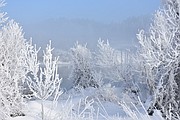A 'hoaribly' frosty morning along the Kootenai River
“Hoarfrost, a grayish-white crystalline deposit of frozen water vapor formed in clear, still weather on vegetation and fences.”
Last Thursday as I was traveling west of Bonners Ferry on the Riverside road in minus-1 degree temperatures I noticed an unusual amount of frost on the trees and vegetation beside Kootenai River. The frost seemed to vary and some of the frost appeared to have extremely exaggerated crystal formations.
I knew that the erratic occurrence of frost in adjacent localities is due partly to differences of elevation, the lower areas becoming colder on calm nights. From high school science I remembered frost was the coating or deposit of ice that may form in humid air in cold conditions, usually overnight. In temperate climates it most commonly appears as fragile white crystals or frozen dew drops near the ground, but in cold climates it occurs in a greater variety of forms. Frost is composed of delicate branched patterns of ice crystals.
Because of the amazing frost I discovered that morning, I decided to contact the weather bureau to determine the name of the frost. After sending two photos via email to the National Weather Service, my response came back with the announcement that the frost was called “hoarfrost.”
According to the National Weather Service office, an old English dictionary around 1290 A.D. defines hoarfrost as “expressing the resemblance of white feather of frost to an old man’s beard.” The name hoar comes from and Old English adjective that means “showing signs of old age.” In this context it refers to the frost that makes trees and bushes look like white hair.
For those of you who were out early last Thursday morning during the frigid temperatures you may have noticed many surfaces coated with a thick, silvery-gray layer of ice crystals. This phenomenon is an example of hoar frost. Hoarfrost is similar to the formation of frost, but at colder temperatures with the dew point, or frost point in this case, well below 32 degrees. Hoarfrost forms and grows when the air is cooled to the frost point and nearby water vapor bypasses the liquid stage as it condenses and is immediately deposited as solid ice crystals. The amount of hoarfrost can be especially great on trees on tree limbs and branches.
I enjoyed the beauty of the hoarfrost along the Kootenai River and its crystal formation, but I do not want to revisit the minus-1 degree temperature for quite some time. That temperature was horrible and frosty.
Enjoy Boundary County’s beautiful wintry outdoors.



